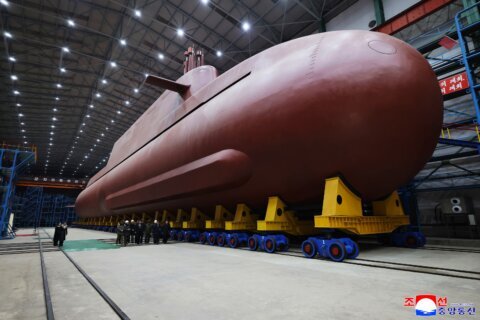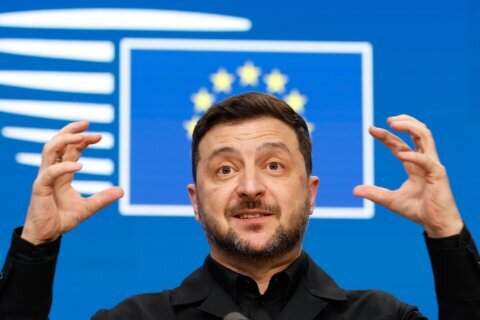In a dramatic escalation of the war with Russia, Ukraine’s military has launched waves of drones at Moscow, destroyed three key bridges in the Kursk region, occupied more than 425 square miles of territory and taken thousands of Russian troops as prisoners of war.
But while the two-week offensive has highlighted Russia’s military struggles, it has at the same time exposed Ukraine’s urgent need of Western assistance.
An adviser in Ukraine’s government told WTOP in an interview they have not received a lot of the Western aid that was pledged.
“In our current situation, delays are very damaging,” said Yuriy Sak, adviser to Ukraine’s Minister of Strategic Industries. “So that’s why we appeal to our partners to speed up the process and the logistics of the transfer of these weapons.”
“The front line now is even bigger than it was before, because we have the Kursk operation and that also requires a lot of power,” Sak said. “That requires a lot of equipment, so the sooner we get that help, the more we will be in a position to achieve our goals and continue our defense.”
For a variety of reasons, several European nations have lagged in supplying promised military assistance to Ukraine.
Asked about Ukraine’s concerns, the top Pentagon spokesman told reporters that making sure Ukraine has what it needs is a U.S. priority.
“We are always looking at ways that we can expedite delivery of capabilities to the Ukrainians,” said Maj. Gen. Pat Ryder during a briefing on Tuesday.
He pointed out that a good way to address Ukraine’s concerns is the Ukraine Defense Contact Group, which meets again in September.
“That will be an excellent forum in which to have discussions to look at processes and procedures, as it relates to ensuring that the Ukrainians have what they need on the battlefield to defend themselves,” Ryder said.
Another key problem, according to Sak, is that Ukraine faces limits on how it can to use U.S. weapons.
“This operation in the Kursk region would not have been necessary if Ukraine had the permission from the United States of America and other allies to use long-range weapons to strike Russian war infrastructure, war machinery inside Russia, and its airfields,” Sak said.
The Kursk incursion has, however, proven to be highly successful.
Professor Michael Clarke, a prominent defense and security analyst, told Sky News Tuesday, “The destruction of these bridges represents a significant counter-punch by Ukrainian forces.”
He added, “With the bridges down, Russian access to the area south of the Seym River is severely restricted. They are currently relying on a pontoon bridge at Glushkovo, which is insufficient for substantial military movements.
According to Clarke, “The Russians will need to construct additional pontoon bridges to reinforce their positions, and this will likely lead to intense engagements over these temporary crossings.”
The counter-offensive by Ukrainian forces is part of a broader strategy that aims to exploit vulnerabilities in Russian defenses.
“While the immediate significance of these actions may appear symbolic, they have already achieved political objectives by rattling the Kremlin and exposing weaknesses in Russian responses,” Clarke explained.
The impact of Ukraine’s incursion is also creating a significant strain on already depleted Russian forces, according to the British military.
In an update on Wednesday, the British Ministry of Defense released a report indicating Russia is having difficulty finding enough people to fight.
The update says that Russia recently formed and deployed a new regiment to defend against Ukrainian advances in the region.
However, the report, quoting an account by Russian investigative outlet Vazhnyye Istorii, indicated that inexperienced Aerospace Forces (VKS) personnel are being moved out of their specialized roles, such as early-warning radar operators and long-range aviation heavy bomber regiments into to infantry positions.
The Ministry of Defense concludes, “diverting personnel from these previously high priority areas likely demonstrates continuing personnel shortages.”
According to a Western intelligence source, the Russian military’s current strategy of reallocating specialized personnel to front line infantry roles is a short-term solution that may have long-term consequences.
“This approach reflects ongoing personnel shortages that are likely to diminish Russia’s overall military effectiveness and ability to sustain prolonged operations, particularly in regions like Kursk,” said the source.
As the conflict continues, Russia’s ability to generate high-capability units will remain constrained, potentially altering the balance of power on the battlefield.
Clarke highlighted that Ukraine’s recent activities in Russia represent a shift in the conflict’s momentum.
“For the first time in over a year, we are seeing Ukraine taking a proactive stance,” he said. “They are not just consolidating their positions but actively pushing forward and forcing the Russians to react. This represents a major change in the strategic landscape.”
Get breaking news and daily headlines delivered to your email inbox by signing up here.
© 2024 WTOP. All Rights Reserved. This website is not intended for users located within the European Economic Area.








